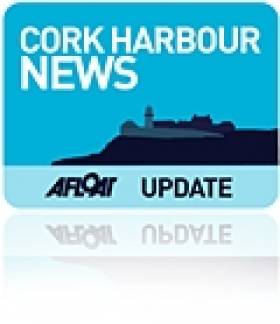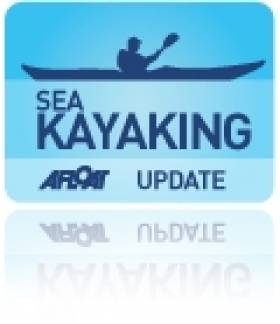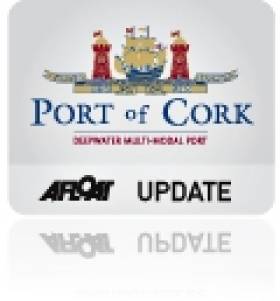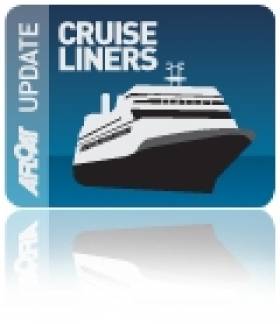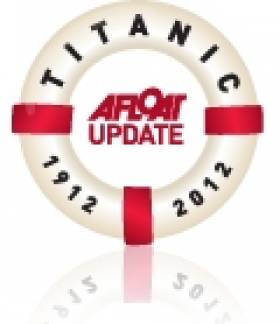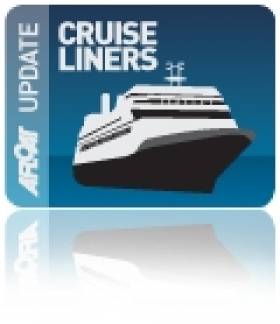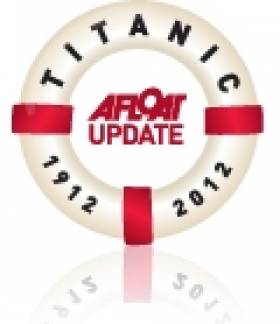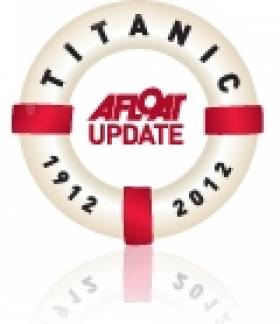Displaying items by tag: Cobh
Cobh-Blackrock Race Raises Funds for Joe English Trust
#cobhtoblackrokrace – 80 boats of all shapes and sizes competed in yesterday's Cork Harbour Cobh to Blackrock race sponsored by the Port of Cork and Union Chandlery and hostedy by Cove Sailing Club.
The "all-in" start for 60 cruisers off the Cobh line was exciting both for the spectators and crews alike.
After racing 40 ribs and boats rafted up at the City Quays marina and a big crowd gathered at the Boardwalk Restaurant for the prize-giving and popular barbecue.
A raffle held after the prize-giving raised a massive €650 for the Joe English Trust.
Corkman Completes Round-Ireland Solo Sea Kayak Challenge
#SEA KAYAKING - It was a lucky Friday the 13th for Cork adventurer Mike Jones who returned to an enthusiastic reception on completing his solo circumnavigation of Ireland by kayak after 40 days at sea.
As previously reported on Afloat.ie, Jones set out from Cobh on Monday 4 June in an 18-foot sea kayak with the aim of completing the charity challenge in under five weeks.
Unfortunately the tumultuous weather of the past few weeks put paid to those plans, but as he told the Cork Independent, he "wasn't that far off" the 35-day mark.
"The weather was of course very bad and it was a battle for the first few days of it," he added. "The longest day for me was crossing Donegal Bay up north where I was kayaking for about 17 hours which was pretty tiring."
Despite the rough conditions, Jones was well prepared for any and all eventualities, even using a VHF radio to keep in regular contact with the Irish Coast Guard and carrying a GPS tracker so visitors to his blog could track his daily progress.
And considering his pedigree as an open-water rower - he became one of the first Cork men to row across the Atlantic Ocean in 2010 - Jones was more than able for the job.
But he also admitted that the kindness he received from strangers was pivotal to his successful effort, which has so far raised almost €3,500 for the Children's Sunshine Home and LauraLynn House for children with life-limiting conditions.
The Cork Independent has more on the story HERE.
Port of Cork Maritime Collection Opens
#portofcork – The Port of Cork Maritime Collection, an exhibition of maritime themed paintings and models is now open at the Sirius Arts Centre, Cobh. The exhibition, which will run until 22nd July, will showcase a selection of the Port's historic maritime art pieces dating back from the 1800s. Highlights of the collection include a number of paintings by marine artist George Mounsey Wheatley Atkinson and Robert Lowe Stopford who is known for his series of panoramic views of Queenstown.
This exhibition offers the public a chance to view this one of a kind collection of paintings and models which are usually housed in the Port's headquarters in Custom House. In 2005, to celebrate Cork's year as Capital of Culture, the Port of Cork hosted an exhibition of maritime art dating back to the 1700s which drew hundreds of visitors from far and wide. In 2010, paintings also went on loan to Dachau museum for an exhibition which formed part of a year-long commemoration of the life and works of renowned Cork composer and conductor Aloys Fleischmann. More recently, in April 2012, paintings went on loan to Belfast Port to form part of their 'Kings of the Tides' exhibition.
Speaking about the exhibition, Chief Executive of the Port of Cork Brendan Keating said "The Port of Cork is delighted that we are able to share our exceptional collection of paintings and models with the people of Cork and beyond. These works give us a glimpse of how our harbour has changed over the years and also reminds us of the rich history of Cork's shipping business. I would like to thank Sirius Arts Centre for hosting our collection and to Peter Murray and the Crawford Gallery for making this exhibition possible."
Entry to the exhibition is free of charge.
For further information, see www.siriusartscentre.ie or phone 021 4813790.
Gallery Opening Hours:
Wednesday – Friday: 11AM - 5PM
Saturday & Sunday: 2PM - 5PM
Monday & Tuesday: Closed
Small Cruiseship Set Sails for Sneem
#COASTING CRUISING – The small expedition cruiseship Clipper Odyssey (1989/5,218grt) departed Cobh Cruise Terminal this evening on a short cruise-hop along the West Cork coastline to Sneem in neighbouring Co. Kerry, writes Jehan Ashmore.
The twin funnelled vessel is normally associated with cruising in the Pacific on cruises from New Zealand to the Russian Far-East. For 2012, however she will be voyaging also to the Scottish Isles, Faroe Islands and Norway having previously served earlier this year on Indian Ocean safari cruises from Zanzibar to Mozambique visiting Madagascar and Mauritius.
A crew of 70 look after 128 guests accommodated in 64 cabins. Of the staterooms they all have ocean views, and each feature lower level beds, a private bathroom, sitting area with sofa, individual temperature control, in-room music systems and television.
At the stern is the fitness suite and outdoor pool. Other facilities include a lounge, library, gym, a medical clinic staffed by a registered physician and a gift shop. The small vessel is ideally suited for calling to shallower waters, where passenger can reach shore destinations using the vessels own tender fleet made up of Zodiac craft.
The Bahamas flagged vessel was last refurbished this time last year and she is operated by Noble Caledonia which specialise in providing a diverse range of cruising opportunities including those sailing under sail.
The company's Caledonia Sky (1991/4,200grt) has also been cruising in Irish waters this week. The 114 passenger vessel is better known as the Hebridean Spirit which had for many years operated for Hebridean Island Cruises. While on a cruise around a decade ago she made a rare promotional port of call to Dun Laoghaire Harbour.
First Irishman to Dive Titanic Site Shares His Story
#TITANIC - To mark the 100th anniversary of the sinking of the Titanic, JOE.ie sat down with the first Irishman to dive the historic wreckage.
In 2000, Rory Golden descended two-and-a-half miles beneath the surface of the Atlantic to witness the Titanic's watery gravesite.
“When I first cast my eyes on the wreck," he says, "for me it was just an incredibly exciting and equally humbling and incredibly poignant moment and you have all these emotions all at once because you are looking at something very few people in the world have seen.”
Amazingly, the self-avowed Titanic expert wasn't originally a part of the dive team for the expedition.
"My role at the time was to be the dive safety supervisor, but that whole role changed over the course of the expedition," he says. “There was no guarantee of me going down there because I was very low in the pecking order."
But a memorial plaque he brought with him from Cobh ended up being Golden's ticket to the TItanic, joining the crew aboard an 18-tonne Russian submarine.
And he came back with more than memories, too, as a glint in the corner of his eye turned out to be the remains of the ship's wheel.
"I was the first person to touch the wheel of the ship since it went down in 1912 and probably the last person to hold it before it went down was Captain Smith.”
JOE.ie has much more on the story HERE.
From Falmouth to the Fjords
#CRUISE LINERS – Dublin Port's first cruise caller for this season will be Arion which today sets sail from Falmouth on an eleven night / twelve day cruise to Scotland and Norwegian fjords. The 5,888 gross tonnes cruiseship built in 1965 is to berth in the capital at Ocean Pier, writes Jehan Ashmore.
The veteran vessel which has sleek traditional lines can carry over 300 passengers and she is operated by Classic International Cruises. Her visit will be one of around 90 cruise calls scheduled to Dublin Port during this year's season which stretches to early October. The majority of these calls will be in the summer and where several ships will be making repeat port of calls.
With so many callers to Dublin Port, this brings a greater variety of vessels as evident between the Arion and Princess Cruises considerably larger Grand Princess which is due next week. The giant vessel weighs over 109,000 gross tonnes and has a capacity for over 4,000 passenger and crew.
The Portuguese flagged Arion is also set to open the season to Galway, as previously reported she is to make an anchorage call off the mid-west harbour next month.
Meanwhile following all the recent focus centred in Cobh, Cruise & Maritime Voyages Marco Polo is expected to arrive this afternoon by berthing at the town's dedicated cruiseship quayside.
President Visits Cobh Commemoration of Titanic 100
#COBH TITANIC 100 – President Michael D Higgins attended a ceremony in Cobh, Co Cork this afternoon to mark the 100th anniversary of Titanic's maiden voyage.
The liner's last port of call was to Cobh (then Queenstown) and was where the last passengers boarded the White Star Line's liner.
The tribute, part of Cobh's Titanic 100 programme of commemorative events, saw a naval fleet review and a flyover from the Irish Air Corps. For more the Irish Examiner has a report.
Titanic Emergency as Ill Passenger Airlifted
#TITANIC - The Titanic memorial cruise was yesterday forced to turn back just 100 miles from the southwest coast of Ireland after a passenger fell ill, BBC News reports.
The Irish Coast Guard rescue helicopter at Shannon was dispached to the MS Balmoral to retrieve BBC cameraman Tim Rex, 56, who was struck by a non-life threatening heart condition, according to the Irish Independent.
Rex, who was covering the memorial sailing for the BBC, was treated by ship's doctors before being airlifted to hospital as a precaution.
The emergency happened just hours after the ship departed Cobh, the last port of call of the ill-fated Titanic before it sank in the North Atlantic on 14 April 1912.
A spokesperson for Titanic Memorial Cruises confirmed that despite the delay, the ship is still on schedule and is expected to arrive at the Titanic wreck site as planned on Saturday.
Photo Exhibition Includes Cobh’s ‘Titanic’ Pier
#PHOTO EXHIBITION -'The Pier' a collection of images created by French photographer Charlie Jouvet was launched this evening at Alliance Francaise, Dublin and continues into next month, writes Jehan Ashmore.
The images portrayed capture a meditative journey from the centre of the island of Cobh to the sea and features the town's former White Star Line pier. It is from this pier that liner tenders took the last passengers to board the R.M.S. Titanic which was anchored offshore.
Jouvet created the images while in residency with the Sirius Arts Centre in Cobh where there have been calls to preserve the historic 19th century pier also known locally as the 'Heartbreak' Pier as many emigrants departed Ireland for the last time and to seek new lives abroad.
Constructed of timber, the pier is in a perilous condition and according to experts could collapse unless urgent funding is found, as previously reported on Afloat.ie
The Berlin-based photographer has exhibited in his native France and also in Cambodia, Germany, Poland and Switzerland. His most recent work was at the PhotoPhnomPenh Festival which was held last November.
The Dublin exhibition continues to 21st April and is open to the public (free of charge) at Alliance Française, 1 Kildare Street, Dublin 2. For further information Tel: (01) 676 1732 and opening hours visit www.alliance-francaise.ie/gallery/
Cobh’s ‘Titanic’ Pier Could Collapse
#TITANIC- In the centenary year of commemorating the R.M.S. Titanic, the pier from where her last passengers boarded at Cobh (Queenstown) is in danger of collapsing unless funding is made available to carry out immediate preservation reports The Irish Times.
The 19th century pier constructed of timber is one of the most tangible links between the town and the liner which anchored offshore and where passengers boarded by tenders.
In addition many emigrants also trundled the pier's planks to depart Irish shores for the final time on ocean-going journeys to the four corners of the world in an effort to start new lives.
To read more about the story click HERE.


























